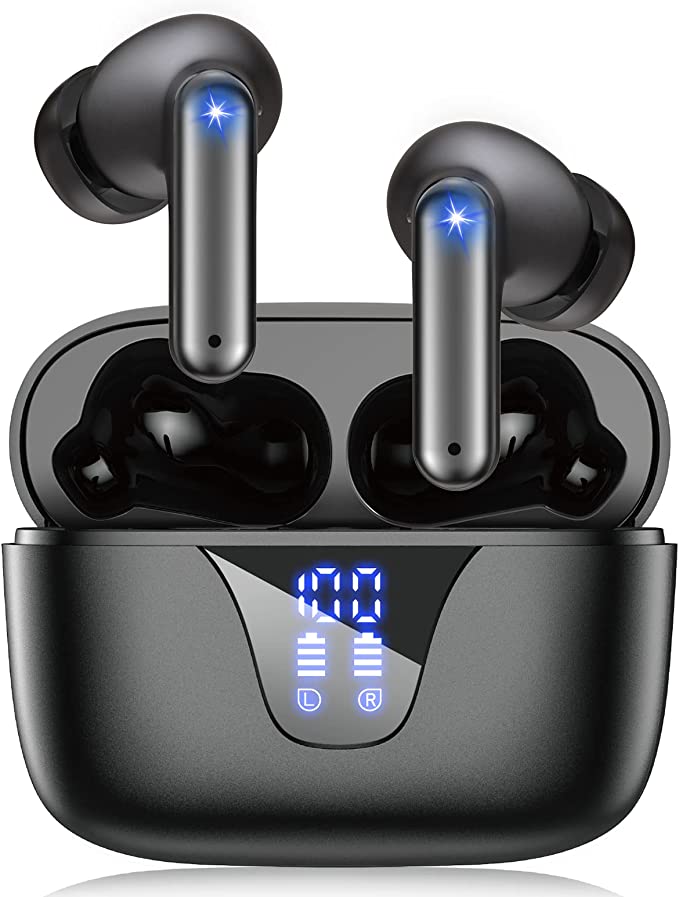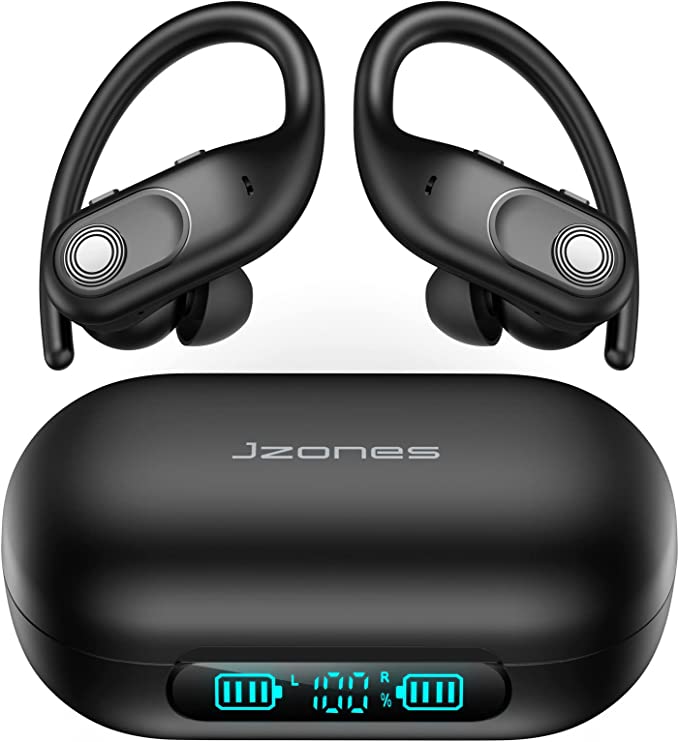Walk down any street, step into any gym, or settle into any commute, and you’ll see them: wireless earbuds, piping music, podcasts, and calls directly into our lives. They’ve become extensions of our digital selves, a near-ubiquitous accessory. But beneath the sleek plastic shells of even affordable models like the ROMOKE T19 Wireless Earbuds, lies a fascinating symphony of scientific principles and engineering feats working in concert. Ever wondered how that tiny bud delivers your favorite song, stays connected to your phone, or shrugs off a rain shower? Let’s put on our tech explorer hats and delve into the science that makes these everyday marvels possible.

The Invisible Tether: Untangling Bluetooth 5.3
Think of Bluetooth as a sophisticated, invisible leash connecting your audio source (like your phone) to your earbuds. It uses short-range radio waves to transmit data wirelessly. The ROMOKE T19 boasts Bluetooth 5.3, the latest iteration in a long line of advancements. But what does “5.3” actually mean for your listening experience, beyond just being a bigger number?
While marketing often touts faster speeds and longer ranges (which are heavily influenced by your environment – walls, other devices, even your own body can interfere!), one of the key practical improvements in Bluetooth 5.3 often lies in its enhanced stability. Imagine being at a busy café with lots of wireless signals flying around – older Bluetooth versions might struggle, leading to annoying audio dropouts. Bluetooth 5.3 incorporates smarter ways to navigate this crowded radio space, akin to being better at picking out a specific conversation in a noisy room (through techniques like improved channel classification). This means a more robust, reliable connection, translating to fewer interruptions in your music or calls.
This version also includes refinements aimed at potentially lower latency (the delay between the video you see and the audio you hear) and slightly better power efficiency compared to its predecessors. While not always dramatic leaps, these incremental improvements contribute to a smoother overall experience.
And that convenient “One-Step Pairing”? After you initially pair the T19s with your device, subsequent connections are lightning fast. This isn’t magic, but rather the earbuds remembering the device’s unique Bluetooth address and using optimized protocols in version 5.3 to quickly re-establish that invisible tether as soon as they leave the charging case.

Crafting Sound Waves: The Driver and the Digital Brain
So, the signal has arrived wirelessly. How does it become sound? The heart of this transformation within each T19 earbud is a 13mm dynamic driver. Picture this as a miniature, high-precision loudspeaker designed specifically for your ear canal.
It works on fundamental physics principles. An electrical audio signal flows into a voice coil attached to a diaphragm (a thin, lightweight membrane). This coil sits within a magnetic field. The changing electrical signal creates a fluctuating magnetic force, causing the coil and the attached diaphragm to vibrate rapidly back and forth. This vibration pushes and pulls the air molecules next to it, creating pressure waves – the very essence of sound – that travel down your ear canal to your eardrum.
Does the “13mm” size matter? Potentially. A larger diaphragm has a greater surface area, meaning it can move more air with each vibration. This is often associated with the ability to reproduce lower frequencies (bass) more effectively, giving sound a sense of fullness or punch. However, driver size is only one part of the acoustic puzzle; the enclosure design and, crucially, the electronic tuning play enormous roles in the final sound signature.
The T19 also lists “DSR Lossless HD Rendering Technology.” It’s important to approach such terms with a critical ear. This is almost certainly a marketing label for a sophisticated Digital Signal Processing (DSP) chip and algorithm working behind the scenes. When audio is sent over standard Bluetooth (likely using codecs like SBC or AAC here, which compress the data to save bandwidth), some audio information is inevitably lost. The goal of DSP like this is to intelligently analyze the received signal and attempt to compensate for these compression artifacts, potentially sharpening details, smoothing out frequencies, and enhancing the overall perceived clarity. While aiming for “HD Rendering” is commendable, achieving truly “lossless” audio (meaning absolutely identical to the original source) over standard Bluetooth connections is technically extremely challenging and often not feasible. Think of it less as perfect restoration and more as intelligent sonic polishing.

The Long Run: Powering Playlists and Calls
These tiny technological marvels need fuel. Inside the earbuds and the charging case are Lithium Polymer (Li-Po) batteries. This battery chemistry is favored in wearables for two key reasons: high energy density (packing a lot of power into a small, light package) and flexibility in shape, allowing designers to fit them into compact and curved forms.
ROMOKE claims the T19 earbuds can last up to 8 hours on a single charge, with the charging case holding enough power for about four additional recharges, bringing the total potential playtime to a respectable 40 hours. That’s enough endurance for several days of typical use, multiple workouts, or even a long-haul flight, significantly reducing charging anxiety. Analogy-wise, it’s like having a main fuel tank in each earbud and a portable jerrycan in the case.
Keeping track of all this power is made simple by the LED Power Display on the charging case. It provides a clear numerical percentage (1-100%) of the case’s remaining charge and often uses separate indicators (like dots or small bars) to show the charging status of each individual earbud nestled inside. This takes the guesswork out of knowing when the case itself needs a top-up via its charging cable.
Everyday Armor: Decoding IP7 Water Resistance
Life is unpredictable. A sudden downpour during your run or an intense workout session inevitably means exposure to moisture. The T19 earbuds come prepared with an IP7 waterproof rating. What does this cryptic code actually signify?
“IP” stands for Ingress Protection, and it’s an international standard (IEC 60529) used to classify how well an electrical enclosure resists intrusion from solids (like dust – the first digit, often ‘X’ if untested) and liquids (the second digit). The “7” in IP7 specifies that the device is protected against the effects of temporary immersion in water under standardized conditions: up to 1 meter depth for a maximum of 30 minutes.
How is this achieved? Typically through a combination of precise seals around openings and, often, a hydrophobic nano-coating applied to the internal electronic components. Imagine this coating as an invisible, high-tech raincoat at a microscopic level, causing water droplets to bead up and roll off rather than penetrating sensitive areas.
For you, the user, an IP7 rating means peace of mind. Your T19s should comfortably handle sweat, splashes, and even being caught in the rain. However, it’s crucial to understand the limits. This rating is based on controlled laboratory tests in fresh water. It does not mean the earbuds are designed for swimming (chlorine or saltwater can be corrosive, and water pressure increases significantly with movement and depth), showering (soap and steam can compromise seals), or any kind of prolonged submersion. Think of IP7 as robust protection against everyday moisture hazards, not an invitation for aquatic adventures.

Command & Conversation: Touch, Mics, and Clarity
Interacting with your audio without constantly reaching for your phone is paramount. The T19 employs Smart Touch Control, most likely using capacitive sensing technology. Your skin is naturally conductive and holds a small electrical charge. The touch-sensitive surface on the earbud constantly monitors its own electrical capacitance. When your fingertip touches it, it disrupts this field in a detectable way, registering a tap, double-tap, or long press. This allows you to control music playback (play/pause, skip tracks), adjust volume (a feature not always present on budget buds), answer or reject calls, and even summon your phone’s voice assistant (like Siri or Google Assistant) with simple gestures.
For making calls or using that voice assistant, the T19 incorporates MEMS microphones. MEMS stands for Micro-Electro-Mechanical Systems – these are incredibly tiny microphones built onto silicon chips, prized for their small size, low power consumption, and consistent performance. But just having a microphone isn’t enough for clear calls in noisy environments. The product description mentions a noise reduction algorithm. This is another form of DSP working specifically on the microphone input. Its job is to analyze the incoming sound, try to identify patterns characteristic of steady background noise (like traffic rumble, air conditioning hum, or crowd chatter), and digitally filter them out, while attempting to preserve and enhance the frequencies of your voice. The goal is to make your voice clearer to the person on the other end of the call. It’s important to note this is typically focused on outgoing audio clarity and is distinct from Active Noise Cancellation (ANC) which works to reduce the noise you hear while listening.

The Fit Factor: Ergonomics and the Subjectivity of Comfort
How an earbud feels and stays in your ear is arguably as important as how it sounds. The T19 utilizes a “half in-ear” design. Unlike fully sealed in-ear monitors that insert deeper into the ear canal, or earbuds that rest just outside (like original AirPods), this style sits more gently in the concha (the outer bowl) of the ear, with a short nozzle directing sound towards the canal. ROMOKE mentions a “curved structure” designed to follow the ear’s contours, aiming for a secure yet comfortable fit, even during activity.
The featherlight weight of just 4 grams per earbud certainly contributes to comfort during long listening sessions. The 40-gram charging case is also easily pocketable. However, there’s no escaping the highly personal nature of earbud fit. Ears come in a vast array of shapes and sizes. While the ergonomic design intends to provide a universally comfortable experience, what feels perfect for one person might feel loose or slightly uncomfortable for another. This half in-ear style might also offer less passive noise isolation (blocking out external sounds) compared to designs that create a tighter seal in the ear canal – a potential trade-off some users might prefer for situational awareness, while others might miss the deeper immersion.

The Universal Handshake: Compatibility
Worried if these earbuds will work with your specific phone or laptop? Thanks to the magic of the Bluetooth standard, compatibility is rarely an issue. As long as your device – be it Android, iOS, Windows, or macOS – has Bluetooth capability, it should be able to connect and communicate with the ROMOKE T19 earbuds without any fuss.

Conclusion: The Sum of the Parts – Accessible Innovation
Looking back, the ROMOKE T19 earbuds, while presented as a simple, affordable audio solution, are a microcosm of incredible technological integration. The invisible dance of radio waves managed by Bluetooth 5.3, the precise mechanical vibrations of the dynamic driver translating electricity into music, the careful chemistry within the Li-Po batteries storing hours of power, the material science shielding against moisture via IP7 standards, and the clever algorithms enabling touch controls and clearer calls – all these elements, honed through decades of scientific research and engineering refinement, converge in this tiny package.
Perhaps the most remarkable aspect is how features that were once the domain of high-end electronics – extended battery life, decent water resistance, stable wireless connections – are increasingly finding their way into accessible products. This democratization of technology, driven by ongoing innovation and manufacturing efficiencies, allows more people than ever to enjoy the convenience and freedom of wireless audio. The next time you pop in your earbuds, take a moment to appreciate the silent symphony of science working diligently, right there in your ear.




